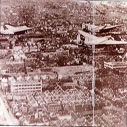|
Overview | Battle in Shanghai | Invasion of Nanking
In 1928 Nanking became China’s capital and by the mid-1930s the population had grown from 250,000 to over a million Chinese. This population increase was mainly due to Japanese occupation in 1931 which caused thousands of refugees to flee to Nanking and other Chinese cities. On November 11, 1937, after Shanghai was under Japanese control, Japanese armies advanced towards Nanking. By early December, Japanese troops were entering the city of Nanking.
On December 9, after the Japanese army failed to get Chinese soldiers to surrender, Japanese launched missile attacks on the city. The Chinese defense retreated to the other side of the Yangtze River. The Japanese entered Nanking from several different directions; 6th and 116th Japanese divisions entered directly into the city, while the 9th entered the Guang Hua Gate, the 16th Division entered the Zhong Shan Gate and the Tai Ping Gate. On December 13, 1937, Nanking fell under the Japanese army and for the next six weeks the city suffered the painful atrocities known as the Rage of Nanking.
Reference:
"Basic facts on the Nanjing Massacre and the Tokyo War Crimes Trial." Japanese Army's Atrocities. 1993.New Jersey Hong Kong Network. 10 Jul 2007
<http://www.cnd.org/njmassacre/nj.html>.
Zhang, "History." Nanking Massacre 1937. 2000. 17 Jul 2007
<http://prion.bchs.uh.edu/~zzhang/1/Nanking_Massacre/history.html>.
|




